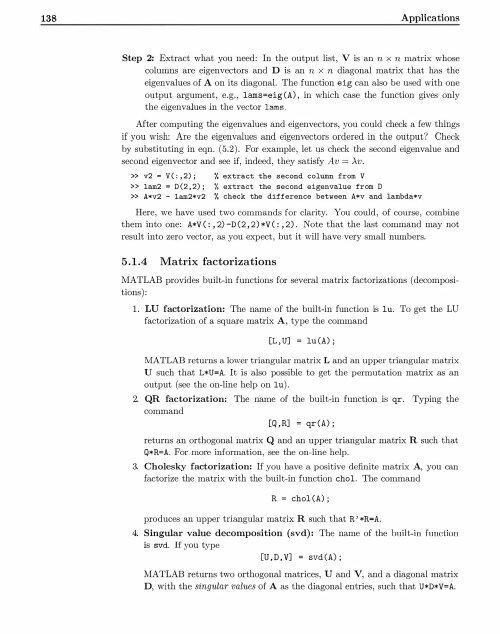Create successful ePaper yourself
Turn your PDF publications into a flip-book with our unique Google optimized e-Paper software.
138 Applications<br />
Step 2: Extract what you need: In the output list, V is an n x n matrix whose<br />
columns are eigenvectors and D is an n x n diagonal matrix that ha."> the<br />
eigenvalues of A on its diagonal. The function eig can also be utied with one<br />
output argument, e.g., lams=eig(A) , in which case the function gives only<br />
the eigenvalues in the vector lams.<br />
After computing the eigenvalues and eigenvectors, you could check a few things<br />
if you wish: Are the eigenvalues and eigenvectors ordered in the output? Check<br />
<strong>by</strong> substituting in eqn. (5.2). For example, let us check the second eigenvalue and<br />
second eigenvector and see if, indeed, they satisfy Av = .\v.<br />
>> v2 = V(:,2 );<br />
>> lam2 = 0(2,2) ;<br />
>> A*v2 - lam2*v2<br />
% extract the second column from V<br />
% extract the second eigenvalue from D<br />
% check the difference between A*v and lambda*v<br />
Here, we have used two commands for clarity. You could, of course, combine<br />
them into one: A*V (: , 2) -D (2, 2) *V (: , 2). Note that the last command may not<br />
result into zero vector, as you expect, but it will have very small numbers.<br />
5.1.4 Matrix factorizations<br />
<strong>MATLAB</strong> provides built-in functions for several matrix factorizations (decompositions):<br />
1. LU factorization: The name of the built-in function is lu. To get the LU<br />
factorization of a square matrix A, type the command<br />
[L ,U] = lu(A) ;<br />
<strong>MATLAB</strong> returns a lower triangular matrix L and an upper triangular matrix<br />
U such that L*U=A. It is also possible to get the permutation matrix as an<br />
output (see the on-line help on lu) .<br />
2. QR factorization: The name of the built-in function is qr. Typing the<br />
command<br />
[Q , R] = qr (A) ;<br />
returns an orthogonal matrix Q and an upper triangular matrix R such that<br />
Q*R=A. For more information, see the on-line help.<br />
3. Cholesky factorization: If you have a positive definite matrix A, you can<br />
factorize the matrix with the built-in function chol. The command<br />
R = chol(A) ;<br />
produces an upper triangular matrix R such that R' *R=A.<br />
4. Singular value decomposition (svd): The name of the built-in function<br />
is svd. If you type<br />
[U ,D,V] = svd(A) ;<br />
<strong>MATLAB</strong> returns two orthogonal matrices, U and V, and a diagonal matrix<br />
D, with the singular values of A as the diagonal entries, such that U*D*V=A.



